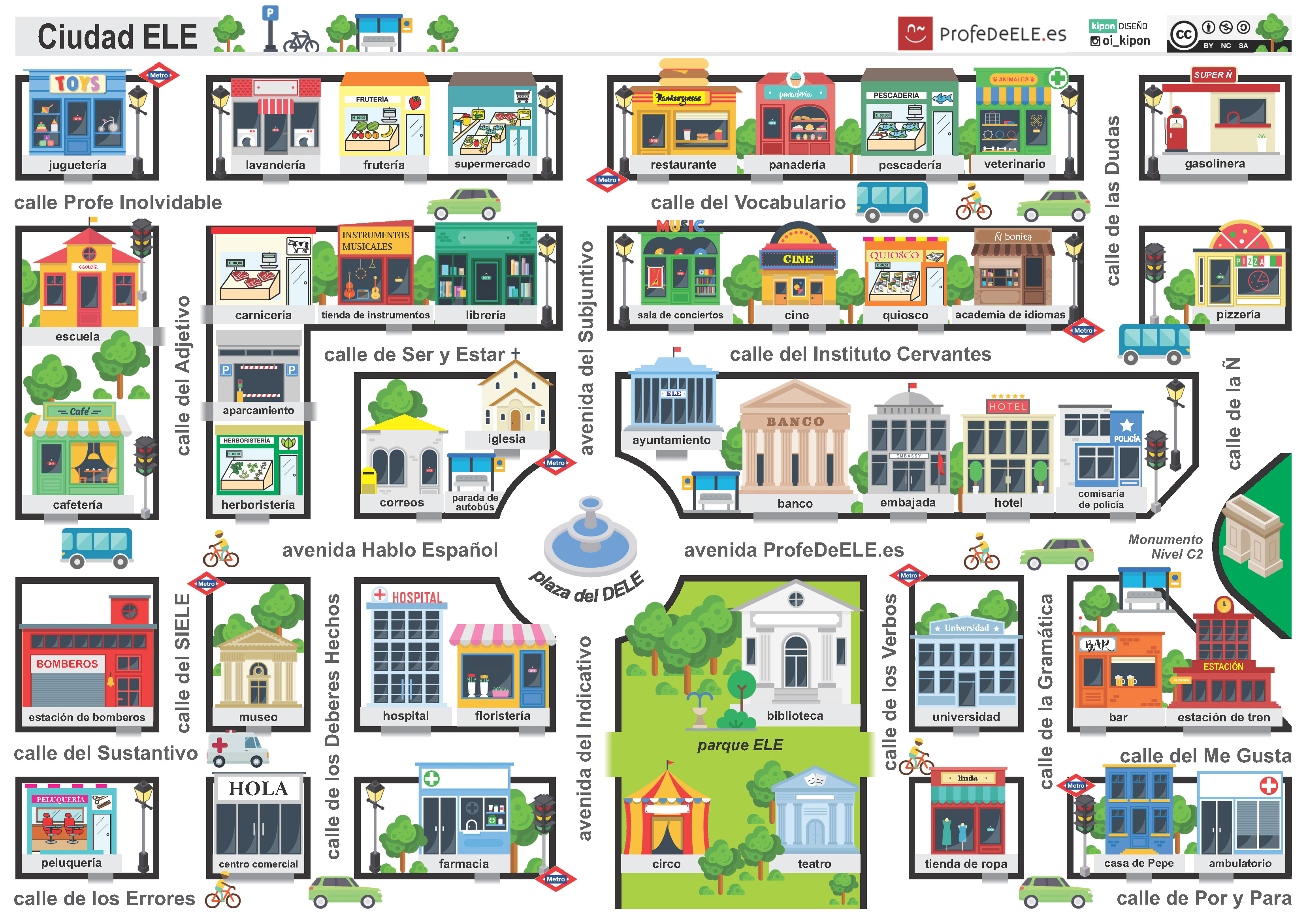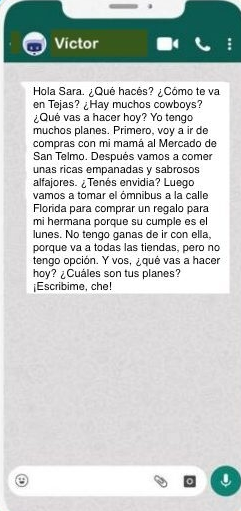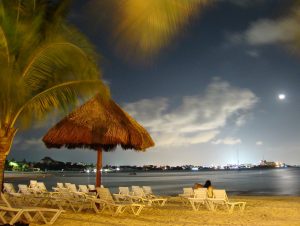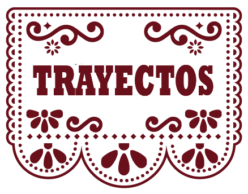Actividades en el futuro: El verbo -ir a + infinitive: Uso y forma
¿A dónde vas?
Do you remember Allison? She is Amy and Rachel’s housemate. She sees Sara before leaving the house. ¿A dónde va Allison? ¿Qué va a hacer allí? Read the conversation. Pay attention to the verbs in bold. What do you notice about these forms? What are their two possible meanings?
Sara: Allison: Sara: Allison: Sara: Allison: Sara: 
¿Comprendiste? Responde estas preguntas sobre el diálogo.
1. Let’s talk about the verb ir first. See if you can find an example of the following in the conversation:
- This verb in the infinitive form;
- This verb used with the “I’m going to + place” meaning; and
- This verb used with the “I’m going to + verb” form (future meaning).
2. Would you say the verb ir is regular or irregular? What are the forms that appear in the dialogue?
3. Now let’s talk about the content of the dialogue (continue paying attention to the verb forms):
a. ¿A dónde va Allison?
b. ¿Qué van a hacer Sara y Amy esta noche? ¿A dónde van a ir?
c. ¿Qué va a hacer Allison? ¿Por qué?
All the conjugated verbs that appear in the dialogue are forms of the present tense conjugation of the verb ir (to go). In this section, we will learn how to conjugate and use this verb. ¡Manos a la obra!
The verb ir is used both to indicate the place where a person is going (Voy a la escuela) and to express future plans (Vamos a comer pizza esta noche). As you have probably noticed, it is an irregular verb. When we use it to talk about the future, it is followed by the preposition a + a verb in the infinitive (e.g., Mis amigas y yo vamos a estudiar esta noche).
I. Conjugación
| Pronombres | Formas de ir |
| yo | voy |
| tú/vos (en Argentina) | vas |
| él/ella/Ud. | va |
| nosotros | vamos |
| vosotros | vais |
| ellos/ellas/Uds. | van |
II. Ir + a + lugar (destination)
One of the ways in which you use the verb ir is to talk about the places where people are going. The conjugated form is followed by the preposition a and the destination.
Tú vas a la escuela.
You are going to school.
¿A dónde van ellos?
Where are they going?
Nosotros vamos al cine.
We are going to the movie theatre.
Yo voy a una fiesta
I am going to a party.
![]() ¡Ojo!
¡Ojo!
Remember the Spanish contraction a + el = al when the preposition a is followed by the masculine article el, as shown in the example Nosotros vamos al (a + el) cine.
III. Ir + a + Infinitive
When you want to express future plans, you use the verb ir + a + a verb in the infinitive.
| Juan va a comprar comida | Juan is going to buy food. |
| Yo voy a estudiar en la biblioteca | I am going to study in the library. |
| ¿Qué van a hacer mañana? | What are y’all/they going to do tomorrow? |
| Allison y yo vamos a limpiar la casa | Allison and I are going to clean the house. |
Ahora mira los primeros 4 minutos de este vídeo. It offers a summary of the verb ir and its two uses.
![]() El verbo ir
El verbo ir
Attribution: By Gregory Gardner, licensed under CC BY 4.0.
Ahora usamos estos verbos para expresar nuestras ideas. Es hora de En esta actividad, vamos a repasar (review) el vocabulario we learned at the beginning of the module, and we will practice the use of ir a. Vas a trabajar con un@ compañer@. Paso 1. Imagine that you and your partner are in a new town. You are trying to figure out where each place is, and where you two and your other friends can do different things. Divide up the following questions between you two. You will take turns asking and answering questions using the map below. Follow the modelo. E1: ¿A dónde vas a estudiar? E2: Voy a la biblioteca o voy (a +el) al café. Paso 2. Now you and your partner are going to choose two or more of the places on the map, and you are going to prepare an itinerary of activities you are going to do there. Use the verb -ir a + infinitive to talk about the future and the vocabulary we learned in Hablemos más. Include at least eight different activities. E1: ¿A dónde vamos? E2: Vamos al parque ELE. ¿Qué vamos a hacer allí? E1: Bueno… (yo) voy a leer las noticias en mi teléfono. ¿Y vos? E2: (Yo) voy a hacer jogging. Now get together with another pair, and share your activities. ¿Son sus actividades similares o diferentes? Write a paragraph together describing where you will go and what you will do, mentioning the similarities and differences. You can use words such as también, y, pero, en contraste, etc. Write at least 100 words. Actividad 1-6. Las actividades de Víctor. El mejor amigo de Sara, Víctor, escribe un texto a Sara. Él habla sobre su día en Argentina. Paso 1. Lee el texto y responde las preguntas. Note: In his text message, Víctor talks about different aspects of Argentinean culture. We have provided you with links below the text so that you can learn more about them. Attribution: By Gabriela C. Zapata, licensed under CC BY-SA 4.0. Enlaces: Preguntas: Paso 2. Imagine you are Sara and just read Victor’s text. Answer his text by describing your plans for today in at least 60 words. Be creative and use some Argentinian Spanish expressions. Here’s a website where you can find some good ones: https://bit.ly/ExpressionsArg Actividad 1-7. Voy a viajar. Paso 1. Ahora hablamos de tus planes para unas vacaciones próximas. Imagine you are going to travel with a group of friends. Write a short paragraph describing what you and your friends are going to do, using ir + a + infinitive. Talk about the place you are going to go to, when you are going to travel, what you are going to do there. Write at least 100 words and complement your paragraph with a photo or link to a video on the place you would like to visit. Here’s an example: “Estas vacaciones de primavera (spring), Jessica, Carina y yo vamos a viajar a Cancún. Vamos a viajar el 15 de marzo y vamos a estar allí hasta el 22 de marzo. Jessica y Carina van a viajar por United y yo voy a ir en Aeroméxico. En Cancún, nos vamos a relajar. Yo me voy a levantar súper tarde y voy a ir todos los días a la playa. Carina y yo vamos a tomar el sol todo el día. A Jessica no le gusta tomar sol y entonces ella probablemente va a hacer excursiones a las ruinas de Chichén Itzá y Tulum. En la noche, vamos a salir a la discoteca y bailar toda la noche. ¡Lo vamos a pasar muy bien!” Attribution: “Cancún”. By navart, licensed under CC BY-SA 2.0. ¡Ahora tú! With a classmate, prepare a conversation. You will need to use the vocabulary structures you learned in this module and the information you developed in Activity 1-7. Include the following information. You and your partner meet at a party before spring break, and you discuss your plans. First, greet each other. Then ask and answer questions about your plans (e.g., where you’re going to go; who you are going to go with; what you’re going to do there, etc.). Include as much information as possible.![]() ¡Manos a la obra!
¡Manos a la obra!![]() Actividad 1-5. ¿A dónde vas para …?
Actividad 1-5. ¿A dónde vas para …? 
![]() Paso 3.
Paso 3.


![]() Paso 2. Now share your plans and photo/video with a classmate. ¿Qué va a hacer tu compañer@? ¿A dónde va a ir? Be ready to tell the rest of the class what they are going to do.
Paso 2. Now share your plans and photo/video with a classmate. ¿Qué va a hacer tu compañer@? ¿A dónde va a ir? Be ready to tell the rest of the class what they are going to do.
![]() Conversemos: ¿A dónde vas a ir estas vacaciones?
Conversemos: ¿A dónde vas a ir estas vacaciones?
Now it’s time to learn more about Sara’s and Víctor’s country. Let’s go to


